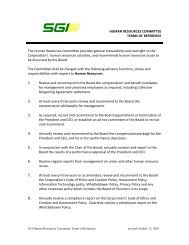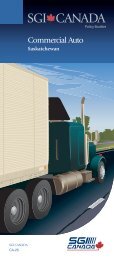Full report - SGI Canada
Full report - SGI Canada
Full report - SGI Canada
You also want an ePaper? Increase the reach of your titles
YUMPU automatically turns print PDFs into web optimized ePapers that Google loves.
3<br />
<strong>SGI</strong> CANADA has defined “industry” for MCT<br />
and combined ratio purposes to represent<br />
P&C companies (both domestic and foreign<br />
branch) with net premium written exceeding<br />
$6 million CDN and excludes all reinsurers,<br />
Lloyd’s, Insurance Corporation of British<br />
Columbia, Manitoba Public Insurance and the<br />
Saskatchewan Auto Fund.<br />
The Corporation targets an after-tax ROE based on its annual budget and it exceeded its target returning<br />
23.1%. <strong>SGI</strong> CANADA’s ROE has been favourable compared to the industry over the years as well. The<br />
industry’s pre-tax ROE for the year is estimated to be 13%, based on data available to the end of the third<br />
quarter of 2010, the most recent time period available. By comparison, <strong>SGI</strong> CANADA’s consolidated pre-tax<br />
ROE was 24.6%. The Corporation’s 10-year average pre-tax ROE is 23%, while the industry averaged 15%<br />
for the same time period. Note that because <strong>SGI</strong> CANADA does not pay income tax on its Saskatchewan<br />
operations, the most relevant ROE comparison to the industry is pre-tax.<br />
For 2011, the target is to achieve a consolidated after-tax ROE of 16.6%, based on the Corporation’s<br />
consolidated budget estimates.<br />
Minimum Capital Test (MCT)<br />
The MCT is a regulatory measure used to assess a company’s financial strength. The MCT is a risk-based<br />
capital adequacy framework that assesses the riskiness of assets, policy liabilities and off-balance sheet<br />
exposures by applying varying factors. From these calculations comes a ratio of capital available to capital<br />
required. The regulatory minimum for this ratio is 150%. That is, capital available has to be at least 50%<br />
more than capital required. The 50% cushion provides comfort for insurers to cope with volatility in markets<br />
and economic conditions, innovations in the industry, consolidation trends, international developments<br />
and to provide for risks not explicitly addressed, including those related to systems, data, fraud, legal and<br />
other risks. The target for 2010 is based on the December 31, 2008, industry 3 average MCT.<br />
The following table shows MCT results by legal entity:<br />
Company December 31, 2010 December 31, 2009<br />
<strong>SGI</strong> CANADA (consolidated) 247% 254%<br />
<strong>SGI</strong> CANADA Insurance<br />
Services Ltd. (consolidated) 361% 358%<br />
Coachman 330% 385%<br />
ICPEI 300% 269%<br />
The above table indicates that all companies have a strong MCT at the end of 2010, well above the<br />
regulatory minimum. <strong>SGI</strong> CANADA’s MCT remains adequate, however decreased slightly due to its 2010<br />
dividend requirement. ICPEI’s increase in its MCT reflects its profitability in 2010, while Coachman’s MCT<br />
declined due to increasing exposure and risks related to the significant growth in the auto book of business.<br />
For 2011, the target is for consolidated operations to have an MCT at 250%. The dividend policy will be<br />
structured to maintain the target MCT.<br />
Manage administrative expenses<br />
To ensure effective use of resources, <strong>SGI</strong> CANADA manages its allocated administrative expense budget<br />
such that the Corporation remains within its targeted administrative expense ratio. The ratio is calculated<br />
as total administrative expenses expressed as a percentage of net premiums earned. The actual<br />
administrative expense ratio is compared to budgeted ratios within the specified time period. For 2010,<br />
<strong>SGI</strong> CANADA exceeded its target with a 12.2% administrative expense ratio. The target for 2011 is 12.5%.<br />
Enhance enterprise risk management (ERM) program<br />
Given the nature of the insurance business, risk management is a particularly important objective.<br />
<strong>SGI</strong> CANADA has been actively identifying, managing and prioritizing its risks for several years. Issues<br />
such as quantifying risks using actuarial modelling techniques will be explored to determine the benefits<br />
of this evolving process in risk management. In 2008, the Corporation completed a gap analysis on the<br />
current process. In 2009, it developed an action plan for ERM, including components and a timetable for<br />
the first implementation phase. The first phase was implemented in 2010.<br />
ERM will continue to be a focus in 2011, but will be removed as a corporate measure on the balanced<br />
scorecard.<br />
Profitable growth<br />
Key to the Corporation’s success is its ability to grow while maintaining profitability in a highly competitive<br />
industry. Operations in provinces outside Saskatchewan continue to be crucial to <strong>SGI</strong> CANADA’s<br />
diversification strategy, however, this strategy also includes maintaining the Corporation’s large market<br />
share within Saskatchewan. It is a basic business principle for insurance companies to reduce the impact<br />
of significant losses by having diversified operations – both geographically and in product mix. Losses<br />
in one product or province can be made up through profits in other products and in other provinces. It is<br />
important for the Corporation to continue to diversify its insured risks, although it is understood that it is<br />
not possible for all segments or markets to be profitable each year. During 2010, 26.7% of direct premiums<br />
written were from outside Saskatchewan, an increase of 4.5% from 2009.<br />
While growth is key to long-term success, the Corporation overall must be profitable in order to sustain<br />
growth. The Corporation recognizes that it cannot lose sight of the Saskatchewan marketplace, the market<br />
where its success developed and that represents the majority of its overall premium base. <strong>SGI</strong> CANADA<br />
strives to continue to grow profitable lines of business in Saskatchewan while maintaining its market share.<br />
<strong>SGI</strong> CANADA uses a number of key performance indicators in its balanced scorecard to monitor the above<br />
initiatives to ensure that it is on course with its strategies:<br />
Legend: ○ achieved h did not achieve<br />
Measure 2010 Target 2010 Results 2011 Target<br />
$338.7 million ○ $344.3 million<br />
Consolidated gross<br />
$103.7 ○ $125.7 million<br />
premium written -<br />
$509.5 million<br />
In-province gross<br />
premium written<br />
Out-of-province gross<br />
premium written<br />
Consolidated<br />
combined ratio<br />
Less than 98% ○ 96.8% 93.4%<br />
In-province gross premium written and out-of-province gross premium written<br />
In 1993, <strong>SGI</strong> CANADA began to diversify its operations with three goals in mind: spreading geographic<br />
risk, creating jobs in Saskatchewan and increasing profits for its shareholder. The current strategy for all<br />
operations is profitable growth. Targets for growth are set in the budget each year. The 2010 target for<br />
in-province gross premium written was $338.7 million, which was exceeded by $5.6 million. The target<br />
for out-of-province gross premium written was $103.7 million, which was exceeded by $22.0 million.<br />
Coachman business contributed the majority of the growth in out-of-province operations, with $49.1 million<br />
in direct premiums, compared to $31.7 million in 2009.<br />
28 | 2010 MANAGEMENT’S DISCUSSION AND ANALYSIS MANAGEMENT’S DISCUSSION AND ANALYSIS 2010 | 29















